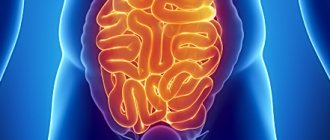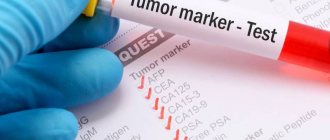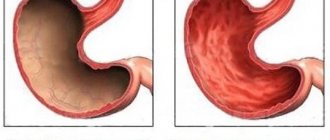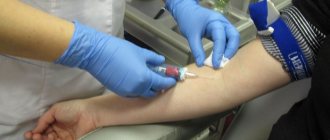Author
Tavolzhanskaya Tatyana Vasilievna
Leading doctor
Family doctor
Blood chemistry
is a laboratory research method that allows, based on the measurement of certain parameters, to gain an understanding of the state of metabolism (proteins, carbohydrates, fats), as well as the functioning of various internal organs. This analysis is informative and has fairly high reliability. Based on the results of the analysis, specialists can get an idea of the functioning of the kidneys, liver, gallbladder, pancreas and some other organs, as well as identify deficiencies of microelements and vitamins. Biochemical blood analysis is used in gastroenterology, therapy, urology, cardiology, gynecology and other areas of medicine.
Everything you wanted to know about biochemical blood test
A standard biochemical blood test allows you to obtain information on the following indicators:
- carbohydrates (fructosamine, glucose);
- enzymes (ALT, AST, alkaline phosphatase, gamma GT);
- pigment substances (bilirubin);
- proteins (total and albumin);
- lipid profile (LDL, total cholesterol, triglycerides);
- nitrogenous compounds (uric acid, urea, creatinine);
- serum iron;
- electrolytes (K, Na, Cl);
- C-reactive protein.
1. Why donate blood for biochemistry.
A biochemical blood test is given to find out:
- how liver cells function;
- how the kidneys cope with urine filtration;
- is there an inflammatory process and how active is it;
- whether pancreatic hormones and digestive enzymes are formed;
- Is absorption good in the intestines?
- is there a risk of diabetes, atherosclerosis and angina;
- is there a need for minerals;
- degree of myocardial damage during infarction.
2. Indications for the study.
When a person seeks help from a doctor with certain symptoms, he is required to undergo a biochemical blood test. Indications for its implementation are:
- Problems associated with the female reproductive system, for example, menstrual irregularities, its disruptions, the cause of which is unclear, infertility, inflammatory processes in the appendages and uterus, ovarian cysts, fibroids, endometriosis.
- Diseases of the gastrointestinal tract and liver (gastritis, pancreatitis, stomach ulcers, enteritis, cholecystitis, gastroenteritis).
- Pathologies of the endocrine system (dysfunction of the adrenal cortex, diabetes mellitus, hyper- and hypothyroidism, suspicion of a tumor of the pituitary gland and hypothalamus, obesity).
- Problems related to the heart and blood vessels (stroke, heart attack, cerebral ischemia, hypercholesterolemia, coronary heart disease).
- Possible liver and kidney failure (to identify and treat the disease).
- Oncology.
- Pathologies associated with the musculoskeletal system of an inflammatory and degenerative nature (osteoporosis, arthritis, arthrosis).
Often, in order to make an accurate diagnosis of a patient, it is enough to conduct a biochemical blood test. However, in some cases it is necessary to resort to additional research methods, depending on the individual characteristics of the person and the course of the disease.
3. Types of biochemical blood tests.
To assess the condition of the patient’s body, the doctor, in addition to the minimal and extended panel, can select indicators that characterize the performance of a particular organ or system. Thus, a biochemical blood test can be of the following types:
- Liver tests, including indicators such as enzymes (alkaline phosphatase, ALT, AST, LDH, GGT), direct and total bilirubin.
- Kidney tests (urea, creatinine, total protein).
- Lipidogram (lipoprotein complexes, cholesterol, triglycerides).
- Acute phase inflammation (fibrinogen, C-reactive protein).
Fats (lipids)
The lipid profile of a biochemical blood test includes all compounds with fatty acids:
- cholesterol (or total cholesterol);
- triglycerides;
- lipoproteins of different densities.
Cholesterol
Cholesterol is the main element of the plasma fat spectrum, which is secreted by the liver and enters the body from food of animal origin. Cholesterol levels increase with age, especially in women.
There are several types of cholesterol:
- Alpha lipoprotein
is the “good” cholesterol. In the results, it is designated by the abbreviation HDL - high-density lipoproteins, which help rid the heart and blood vessels of fatty deposits. - Beta lipoprotein
is “bad” cholesterol of two types: LDL (low-density lipoprotein) and VLDL (very low-density lipoprotein). This type of cholesterol transports fat molecules to internal organs and contributes to the development of diseases of the cardiovascular system.
Increased cholesterol is called hyperlipidemia, and is caused by hereditary problems with fat metabolism. In addition, the amount of cholesterol in plasma increases in certain diseases: coronary heart disease, diabetes mellitus, atherosclerosis, renal failure, hypothyroidism.
A critical decrease in cholesterol in a biochemical blood test signals problems with the gastrointestinal tract (poor intestinal absorption), lack of nutrition, and is also a symptom of liver cirrhosis.
Triglycerides
Triglycerides are lipid organic compounds called neutral fats. Triglycerides are used as an energy resource: cell nutrition depends on the normal amount of fatty acids.
An increase in triglycerides indicates a violation of fat metabolism, renal and liver failure, which is typical for diabetes mellitus, hypothyroidism, obesity, cardiac ischemia, and also when taking hormonal drugs.
A decrease in triglyceride levels in tests may indicate starvation of the body, hyperthyroidism, kidney problems, or an excess of vitamin C.
Preparing for a biochemical blood test
In order for the results of a biochemical blood test to be as informative as possible, you should prepare for its delivery. To do this, you need to take into account a few simple requirements.
To carry out the analysis, you need about 5 ml of venous blood, distributed over several tubes. It is worth noting that the indicators can be affected by a variety of factors, ranging from the food that the patient ate on the eve of the test and the water he drank, to physical activity, emotional arousal, and also taking certain medications.
That is why before visiting the laboratory you must adhere to the following rules:
- do not eat 10–12 hours before donating blood for analysis;
- you should not drink strong tea and coffee in the second half of the day preceding the study;
- Eliminate fatty, spicy, fried foods, alcoholic drinks, etc. from the diet for two to three days.
- give up procedures such as a hot bath, sauna or steam bath, as well as excessive physical activity one day before;
- Before donating blood on the same day, you cannot take medications, perform various manipulations and medical procedures (injections, intravenous administration of drugs, fluorography, dental treatment);
- on the day of collection, you need to avoid morning jogging, physical exercise, and long walks (including to the laboratory), otherwise the results may be unreliable;
- avoid nervous tension, stress, emotional overexcitation (this can also affect performance);
- before donating blood, you need to sit for 10 minutes and calm down, restore your heartbeat and breathing;
- if the blood is tested for glucose to diagnose diabetes, then in the morning you should not drink any drinks, not even water, brush your teeth (especially with toothpaste), or chew gum, since taste buds activate the activity of the pancreas and the production of insulin;
- a day before the analysis, stop taking hormonal, diuretic, thromboral-absorbing, antibacterial medications, as well as drugs that affect blood viscosity;
- to determine the amount of cholesterol in the blood while taking statins, you should stop the course 10–14 days before the test (only in consultation with your doctor);
- if a repeat test is necessary, blood donation should take place under exactly the same conditions at the same time and place (ideally, it is necessary to take an identical route from home to the laboratory on foot or by transport).
What is the best way to prepare for donating blood for biochemistry?
The strict instructions for this test are not to eat food 6-10 hours before donating blood; you are allowed to drink only plain water. One day before taking blood, it is necessary to avoid drinking alcohol, and 1 hour before taking blood, smoking should be avoided. There should be at least 12 hours between the last meal and the blood draw. Juice, tea, coffee, chewing gum are also not allowed. It is necessary to exclude increased psycho-emotional and physical stress. The analysis is carried out in the morning, blood is drawn from a vein.
The editors thank the specialists of the MedCenterService network of clinics for their assistance in preparing the material.
Biochemical blood test indicators
It is not scary if the indicators obtained as a result of a biochemical blood test differ in each clinic, since there is a range of normal values. The final word regarding whether the indicators are considered low, high or acceptable always remains with the attending physician, who makes conclusions in accordance with the medical history.
Table of normal indicators for biochemical blood tests:
If we talk about what is included in a detailed biochemical blood test, then these are indicators both for preventive studies carried out periodically, and for identifying serious diseases and disorders. However, in the first case, there is no point in detailed biochemistry, as well as in the presence of certain symptoms and specific complaints. Additional indicators are included in the analysis depending on the health status of the person who consults the doctor.
The fact is that if a patient complains of extreme thirst, then first of all the amount of glucose in the blood will be checked. If the problem is high blood pressure, attention is paid to the lipid spectrum. In case of anemia, they look at transferrin, iron, ferritin, TIBC, that is, the iron-binding capacity of serum. If the doctor suspects problems with the liver, as well as hepatitis, then indicators such as bilirubin, liver enzymes (ALT, AST and alkaline phosphatase) are assessed.
Recommended articles on the topic:
- How to massage the abdomen for weight loss: different techniques for health and beauty
- Stone massage: description, benefits, methods
- MRI of three parts of the spine: when is it necessary and what are the features of the procedure
Decoding the biochemical blood test
1. Indicators of total protein and fractions.
In the results of biochemical analysis and clinical research, the amount of total protein and proteins, that is, its fractions, is necessarily assessed.
At least 160 different proteins can be found in the blood, which are combined into three protein fractions (according to functions and composition): globulins (4 types), albumins, fibrinogens.
Without proteins, the body cannot function properly. However, their content in a biochemical blood test is below normal, indicating that the liver, which is responsible for the production of proteins, is not capable of synthesizing them. This, in turn, may indicate diseases associated with this organ. In addition, such indicators can cause:
- low protein diet (fasting, vegetarianism, diet with limited protein foods);
- parasitosis, in particular helminthic infestations;
- blood loss caused by heavy menstruation, external or internal bleeding due to injury or illness;
- extensive skin burns;
- kidney disease with excessive release of proteins during urination, proteinuria of the gestational period, etc.;
- hepatitis, cirrhosis with reduced protein synthesis;
- long-term use of glucocorticosteroids;
- development of malignant tumors of the stomach and bladder;
- poor absorption of nutrients in the intestine with colitis, enteritis, celiac disease and pancreatitis;
- ascites, pericarditis and ascites accompanied by plasma accumulation.
To diagnose diseases associated with parenchymal organs in a patient, identify rheumatism, and also if there are signs of the development of neoplasms, the doctor pays attention to the concentration of albumin in the blood. It can also be used to judge the effect of hormonal drugs and the consequences of fasting and dieting on the body.
If the indicators of the protein fraction of albumin in a biochemical blood test in an adult are below normal, this may indicate the development of nephrotic syndrome, renal or liver failure, the presence of tumors of the digestive system, cardiospasm, processes of tissue breakdown, paracentesis, lymphorrhea, exhaustion, etc.
2. Nitrogen metabolism.
When conducting a basic biochemical blood test, as a rule, creatinine and urea are examined, and other components related to low molecular weight nitrogenous substances (residual nitrogen, uric acid, ammonia) are added if it is necessary to verify or refute the presence of other pathologies and disorders.
The functioning of living organisms is always accompanied by the breakdown of cells and tissues, during which the production of nitrogenous compounds occurs. When, according to the results of the study, a deviation from the norm is observed, we can talk about disturbances in the functioning of the liver (nitrogen compounds are synthesized during the breakdown process), kidneys (accumulation due to poor filtration and incorrect excretion in the urine), and increased breakdown of proteins caused by various factors.
| Connection name | What does exceeding the norm indicate? |
| Urea | Hepatic or renal failure, hypertension, exposure to toxic substances, compartment syndrome |
| Creatinine | Severe lesions and diseases of parenchymal organs, impaired functioning of the adrenal glands, tumors, diabetes mellitus |
| Uric acid | Leukemia, gouty syndrome, anemia with vitamin B12 deficiency, dermatitis, poisoning, acute infectious process, liver disease |
If there is a decrease in nitrogen compounds in the blood, this may indicate liver failure, polyurine, hypothyroidism, prolonged fasting, or poor metabolism. In addition, such indicators can occur after hemodialysis and with the administration of intravenous glucose.
3. Carbohydrates in the blood.
Glucose is the main marker of carbohydrate metabolism occurring in the body. If a biochemical analysis shows an increase in the indicator, this indicates that the person has diabetes or a condition preceding it. However, in some cases, such results can occur due to burns, injuries, consumption of large amounts of sugar, and poor preparation for the test. Sometimes an increased amount of glucose in the blood is observed in diseases associated with the liver or pancreas.
To identify disorders of carbohydrate metabolism, in addition to assessing blood glucose, doctors may prescribe a determination of the amount of glycated or glycolyzed proteins (glycolyzed hemoglobin, glycated albumin (fructosamine), glycated lipoprotein).
If glucose levels in a biochemical blood test are below normal, this indicates hypoglycemia, if higher, this indicates hyperglycemia.
| Possible causes of hypoglycemia | Possible causes of hyperglycemia |
| Poor nutrition, fasting and dieting | Diabetes mellitus type 1 and 2 |
| Diseases associated with the gastrointestinal tract that cause poor absorption of carbohydrates (colitis, enteritis, etc.) | Injuries, brain tumors (often pituitary gland) |
| Hypothyroidism | Tumor neoplasms, diseases of the adrenal cortex |
| Liver diseases | Thyrotoxicosis, diseases associated with the thyroid gland |
| Long-term uncontrolled use of drugs containing insulin, as well as hypoglycemic medications | Epileptic syndrome |
| Encephalitis, meningitis, meningoencephalitis | Increased excitability, psycho-emotional instability |
| Insufficiency of adrenal cortex function | Long-term treatment with glucocorticosteroids |
4. Pigments in biochemical blood analysis.
As a result of combining with iron, chromium or copper, some types of proteins acquire a specific color. As they break down, bilirubin is released into the blood, which can be in free or indirect form. Further, during certain processes, it is transformed into a bound state.
In a biochemical blood test, three hemoglobinogenic pigments are identified, namely total, direct (conjugated, bound) and indirect (unbound, free, unconjugated) bilirubin. All of them can indicate the presence of diseases or pathologies in the body. In this case, special attention is paid to free bilirubin, since it is toxic.
An increase in pigment in the blood can occur as a result of genetic diseases, organ or tissue transplantation, or blood transfusions. The basis of diagnosis is the ratio of bilirubin fractions. For example, if elevated levels are observed, this may indicate diseases of the biliary tract or liver.
5. Bilirubin.
After bilirubin passes through the gallbladder and liver, it ends up in the intestines. Here it is converted into urobilinogen compound, that is, a pigment that colors feces and urine.
If the gallbladder, liver or bile ducts are not working well, then some of the bilirubin may remain in the human body. As it spreads through the tissues, they will turn yellow. The well-known name “jaundice” arose precisely because of this symptom. However, many are mistaken when they associate this disease only with hepatitis A. At the moment, jaundice can appear for three reasons:
- Due to poisoning of the body, including toxic, hemolytic anemia and pathologies of the spleen with concomitant hyperfunction. When the pigment protein breaks down too quickly, unbound bilirubin is produced in such quantities that the liver cannot process it. As a result, it begins to accumulate in tissues and blood.
- Due to liver failure caused by injury, hepatitis, tumors and cirrhosis, when the organ cannot process the required amount of bilirubin.
- This can be observed in diseases such as cholelithiasis, cholecystitis, acute cholangitis and tumors. All of them lead to the fact that the outflow of bile from the gallbladder is hampered due to compression of the pathways, and bilirubin flows back into the blood, and then into the tissues.
Total bilirubin is one of the main indicators of a biochemical blood test. As a rule, to diagnose diseases such as liver cirrhosis, jaundice, hepatitis of various etiologies, when characteristic symptoms appear, a specialist examines the level of fractions, that is, bilirubin (unbound and conjugated).
6. Lipids.
No less important indicators in a biochemical blood test are those that indicate the content of fats (lipids). They, in turn, make up the lipid spectrum. During the study, the specialist evaluates the level of lipoproteins (high, low density), which are commonly called “bad” or “good” cholesterol, total cholesterol and triglycerides. Based on the data obtained and the ratio of components, the atherogenicity coefficient is determined. If there is a need to clarify the diagnosis, an additional study is carried out to determine the amount of phospholipids.
We recommend
Anti-wrinkle facial massage: 10 effective techniques More details
7. Cholesterol levels.
In an adult who has no health problems, the level of total cholesterol in a biochemical blood test should be in the range of 3.0–5.2 mmol/l, with 40–60% of it being considered “good.”
Cholesterol in the body can be contained in the form of a high molecular weight compound with proteins and low molecular weight. High-density lipoproteins, produced largely in the liver, are involved in the regulation of processes associated with hormones, the psycho-emotional state, as well as in the formation of the cell membrane, etc.
If we talk about low and very low density lipoproteins, they enter the human body most often with food. Over time, these compounds begin to accumulate in blood vessels and turn into cholesterol plaques. This in turn leads to the fact that the lumen of the vessel becomes narrower, and the blood supply to organs and tissues decreases. However, even in the case of destruction of lipoprotein accumulations, there is a danger that their fragments can lead to the formation of blood clots.
| Increased total cholesterol | Lowering total cholesterol |
| Poor nutrition, diabetes, obesity, myocardial infarction, hypertension, alcoholism, ischemia, gestation period, cholelithiasis, etc. | Liver pathologies, malnutrition, hyperthyroidism, gastrointestinal diseases in which lipid absorption is difficult, chronic obstructive pulmonary disease, rheumatoid arthritis |
8. Enzymes.
When it comes to enzymes in a biochemical blood test, these are most often “liver tests”, amylases, ALT and AST. If an extended study is carried out, then this list increases significantly.
9. Analysis for “liver tests”.
ALT levels, that is, alaminoninottransferase, provide information regarding how efficiently the liver works in the body. In some cases, they talk about problems with the heart muscle or skeletal muscles.
A blood test for the level of AST (aspartatominotransferase) is performed if there is a suspicion of diseases and pathologies of the liver, heart (rheumatic carditis, myocardial infarction, angina), as well as infectious inflammatory processes.
10. Alpha amylase and pancreatic amylase.
Without the presence of these enzymes in the blood, the breakdown of complex carbohydrates would be impossible. For diagnostic purposes, a biochemical blood test examines the concentration of amylase, and the indicators can be either below normal or above it.
As a rule, an increase indicates the presence of diseases associated with the pancreas. In some cases, a high concentration of amylase may indicate viral hepatitis, mumps (endemic mumps), alcoholism, and renal failure. In addition, an excess of amylase in the blood is observed with long-term use of glucocorticosteroids and tetracycline drugs.
Based on a drop in values below normal in a biochemical blood test, the following diseases and conditions can be diagnosed:
- thyrotoxicosis;
- gestational toxicosis accompanying the first trimester of pregnancy;
- necrosis of pancreatic tissue;
- myocardial infarction.
11. Creatine kinase and its fractions.
Based on the concentration of the creatine kinase enzyme in the blood, the specialist assesses how efficiently energy metabolism occurs in the tissues of the heart (CF), muscles (MM fraction), and brain (BB). Indicators above normal indicate that there is accelerated tissue breakdown. In order to diagnose myocardial infarction, understand how much tissue is affected, and also make a prognosis, the CF subtype of creatine kinase is used.
12. Lipase.
Lipase is responsible for the breakdown of neutral fats in the human body. Also, to obtain a more accurate diagnosis and information regarding how affected the organ is, the pancreatic lipase indicator is used, which is more valuable in terms of information content than amylase.
General blood test
Is your ESR level elevated? Warning sign
Blood sampling for a general blood test is carried out from a finger or from a vein and must be done on an empty stomach.
If you suspect stomach cancer, special attention is paid to the following blood parameters:
- With various malignant neoplasms in the human body, the ESR indicator almost always increases. An erythrocyte sedimentation rate of 15 mm/h is considered normal, and a sharp increase in it indicates the presence of an acute inflammatory process in the body. In gastric cancer, ESR indicators practically do not change during antibacterial treatment.
- In the initial stages of pathology, leukocyte counts slightly decrease or remain normal. With the further development of a malignant neoplasm in the human body, a significant increase in the number of leukocytes occurs. In addition, the presence of a large number of young forms is detected in the blood.
- With cancer of the stomach, hemoglobin most often decreases to 90 g/l. This is due to the fact that the patient begins to consume less nutrients, because the tumor interferes with normal absorption. At the last stage of development, anemia occurs due to the active disintegration of the tumor and the development of bleeding from it.
- With stomach cancer, the number of red blood cells decreases to 2.4 g/l.
Often such changes are detected in patients with other pathologies that can be successfully treated.











